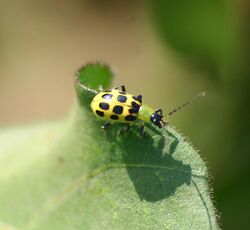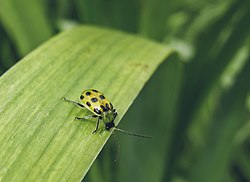Biology:Diabrotica undecimpunctata
| Spotted cucumber beetle | |
|---|---|

| |
| Scientific classification | |
| Domain: | Eukaryota |
| Kingdom: | Animalia |
| Phylum: | Arthropoda |
| Class: | Insecta |
| Order: | Coleoptera |
| Infraorder: | Cucujiformia |
| Family: | Chrysomelidae |
| Genus: | Diabrotica |
| Species: | D. undecimpunctata
|
| Binomial name | |
| Diabrotica undecimpunctata Mannerheim, 1843
| |
Diabrotica undecimpunctata, the spotted cucumber beetle or southern corn rootworm, is a species of cucumber beetle that is native to North America. The species can be a major agricultural pest insect in North America. Spotted cucumber beetles cause damage to crops in the larval and adult stages of their life cycle. Larvae feed on the roots of the emerging plants, which causes the most damage since the young plants are more vulnerable.[1] In the adult stage the beetles cause damage by eating the flowers, leaves, stems, and fruits of the plant[1] The beetles can also spread diseases such as bacterial wilt and mosaic virus.[2]
Description
The three primary types of cucumber beetles are the spotted cucumber beetle, the banded cucumber beetle (Diabrotica balteata), and the striped cucumber beetle (Acalymma vittatum).[3] In North America, the spotted and striped cucumber beetles are the most commonly encountered varieties.
The spotted cucumber beetle has three subspecies, each with a different common name:
- Diabrotica undecimpunctata howardi – spotted cucumber beetle or southern corn rootworm[4]
- Diabrotica undecimpunctata tenella – western cucumber beetle[5]
- Diabrotica undecimpunctata undecimpunctata – western spotted cucumber beetle[6]
In the adult form, it eats leaves of many crops, including squash, cucumbers, soybeans, cotton, beans, and corn. Adult beetles lay eggs in the soil near a cucurbit plant. In a lifetime, females can lay between 150-400 eggs. However, there have been cases in which females have surpassed this quota, with some laying a total of 1,200 eggs.[7] The eggs hatch around mid spring and take 6–9 days to hatch under favorable conditions.[1] In some cases, specifically when the climate is at a lower temperature, eggs can take 30 days to hatch.[8] The ideal soil for egg survival is moist.[8] The larval stage lasts around 2–3 weeks[1] and the larvae are yellowish and wormlike.[9] After the larval stage insects become pupae, this stage lasts for 6–10 days.[10] The pupae measure around 6.25 millimeters in length and 3.5 millimeters in width. They feature a pair of robust spines located at the end of their abdomen, along with smaller spines on the upper side of their other abdominal segments.[11] After 6–10 days the adult beetle emerges. Adult beetles are greenish-yellow with six large black spots on each elytron. They are about 0.5 cm long.[12] In the summertime, adults usually have a lifespan of 60 days, while in winter, they can survive for as long as 200 days.[11]
Distribution
This species is found throughout southern Canada , the continental United States , and the central highlands of Mexico,[13] but is particularly widespread throughout the southern states.[14]
Mating
During mating, the male spotted cucumber beetle positions himself on top of the female. Frequently, the female will make efforts to dislodge him. If the male manages to maintain his position despite the female's attempts, he will commence a gentle stroking of the female's antennae, eyes, and prolegs using his own antennae. This behavior is commonly referred to as 'antennal stroking.'[15]
Before accepting a reproductive partner, a female spotted cucumber beetle may mate with up to 15 males.[16]
Diet
Adult Spotted Cucumber beetles consume over fifty different types of crops and wild plants, including corn, peanuts, beans, apples, cherries, clovers, lettuce, potatoes, and more. Spotted Cucumber Beetles are classified as generalist feeders, which means they consume a wide variety of foods, however they often prefer cucurbits (plants belonging to the gourd family).[17]
Predators and biological control
The spotted cucumber beetle faces predation from a variety of insects and animals. Carabid beetles and wolf spiders, for example, are known to prey upon the Spotted Cucumber Beetle, and their presence in cucumber and squash fields has been associated with reduced beetle populations. Research has indicated that encouraging populations of these predators can be an effective biological control strategy.[18] Additionally, various birds, mammals, and amphibians feed on the Spotted Cucumber Beetle, while the beetle's eggs are targeted by spiders, ground beetles, ants, and crickets.[19]
References
- ↑ 1.0 1.1 1.2 1.3 "spotted cucumber beetle - Diabrotica undecimpunctata howardi Barber". http://entnemdept.ufl.edu/creatures/VEG/BEAN/spotted_cucumber_beetle.htm.
- ↑ Almanac, Old Farmer's. "Cucumber Beetles" (in en). https://www.almanac.com/pest/cucumber-beetles.
- ↑ Gill, Harsimran; Goyal, Gaurav; Kaufman, Jennifer (September 2013). "common name: spotted cucumber beetle". https://entnemdept.ufl.edu/creatures/veg/bean/spotted_cucumber_beetle.htm#:~:text=Spotted%20cucumber%20beetle%20is%20more,very%20common%20(Webb%202010)..
- ↑ "Cucumber beetles". UMN Extension. https://extension.umn.edu/yard-and-garden-insects/cucumber-beetles. Retrieved 24 July 2019.
- ↑ "D. undecimpunctata tenella LeConte". USDA-APHIS Identification Technology Program. http://idtools.org/id/beetles/diabrotica/factsheet.php?name=6831. Retrieved 24 July 2019.
- ↑ "Identification & Management of Major Pest & Beneficial Insects in Potato". Oregon State University. http://uspest.org/potato/wcucumbeetle.pdf. Retrieved 21 May 2019.
- ↑ Peters, Leroy L. (1988-01-01). "Western Corn Rootworm and European Corn Borer Control, 1986". Insecticide and Acaricide Tests 13 (1): 230–230. doi:10.1093/iat/13.1.230. ISSN 0276-3656. http://dx.doi.org/10.1093/iat/13.1.230.
- ↑ 8.0 8.1 Krysan, James L. (June 1976). "MOISTURE RELATIONSHIPS OF THE EGG OF THE SOUTHERN CORN ROOTWORM, DIABROTICA UNDECIMPUNCTATA HOWARDI (COLEOPTERA: CHRYSOMELIDAE)" (in en). Entomologia Experimentalis et Applicata 20 (2): 154–162. doi:10.1111/j.1570-7458.1976.tb02628.x. https://onlinelibrary.wiley.com/doi/10.1111/j.1570-7458.1976.tb02628.x.
- ↑ "Spotted Cucumber Beetle? - Diabrotica undecimpunctata". bugguide.net. http://bugguide.net/node/view/119115.
- ↑ Treat, Asher E. (1970-03-16). "Wormlike Objects (Nematode Larvae?) on Two Gamasine Mites Taken from Noctuid Moths". Annals of the Entomological Society of America 63 (2): 619–620. doi:10.1093/aesa/63.2.619. ISSN 1938-2901.
- ↑ 11.0 11.1 Peters, Leroy L. (1988-01-01). "Western Corn Rootworm and European Corn Borer Control, 1986". Insecticide and Acaricide Tests 13 (1): 230–230. doi:10.1093/iat/13.1.230. ISSN 0276-3656. http://dx.doi.org/10.1093/iat/13.1.230.
- ↑ "Spotted Cucumber Beetle? - Diabrotica undecimpunctata - BugGuide.Net". https://bugguide.net/node/view/119115.
- ↑ "Diabrotica undecimpunctata". Data Sheets on Quarantine Pests. European and Mediterranean Plant Protection Organization. http://www.eppo.int/QUARANTINE/insects/Diabrotica_undecimpunctata/DIABUN_ds.pdf. Retrieved 2012-06-20.
- ↑ "EENY572/IN1008: Spotted Cucumber Beetle Diabrotica undecimpunctata howardi Barber (Insecta: Coleoptera: Chrysomelidae)" (in en). https://edis.ifas.ufl.edu/publication/IN1008.
- ↑ Tallamy, Douglas; Powell, Bradford; McClafferty, Julie (July 1, 2022). "Male traits under cryptic female choice in the spotted cucumber beetle (Coleoptera: Chrysomelidae)". https://academic.oup.com/beheco/article/13/4/511/207949.
- ↑ Tallamy, Douglas W.; Gorski, Piotr M.; Burzon, Julia K. (2000). "Fate of Male-derived Cucurbitacins in Spotted Cucumber Beetle Females". Journal of Chemical Ecology 26 (2): 413–427. doi:10.1023/a:1005461522609. ISSN 0098-0331. http://dx.doi.org/10.1023/a:1005461522609.
- ↑ Haber, Ariela I.; Pasteur, Kayla; Guzman, Filadelfo; Boyle, Sean M.; Kuhar, Thomas P.; Weber, Donald C. (2023-01-01). "Spotted cucumber beetle (Diabrotica undecimpunctata howardi) is attracted to vittatalactone, the pheromone of striped cucumber beetle (Acalymma vittatum)" (in en). Journal of Pest Science 96 (1): 21–27. doi:10.1007/s10340-022-01586-1. ISSN 1612-4766. https://doi.org/10.1007/s10340-022-01586-1.
- ↑ Snyder, William E.; Wise, David H. (July 1999). "Predator Interference and the Establishment of Generalist Predator Populations for Biocontrol" (in en). Biological Control 15 (3): 283–292. doi:10.1006/bcon.1999.0723. https://linkinghub.elsevier.com/retrieve/pii/S1049964499907235.
- ↑ Phillips, Benjamin W.; Gardiner, Mary M. (January 2016). "Does local habitat management or large-scale landscape composition alter the biocontrol services provided to pumpkin agroecosystems?" (in en). Biological Control 92: 181–194. doi:10.1016/j.biocontrol.2015.10.001. https://linkinghub.elsevier.com/retrieve/pii/S1049964415300311.
External links
- "Diabrotica undecimpunctata howardi (DIABUH)[Datasheet]". EPPO (European and Mediterranean Plant Protection Organization). 2021-09-09. http://gd.eppo.int/taxon/DIABUH/datasheet.
Wikidata ☰ Q1615807 entry
 |



